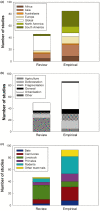Emerging zoonotic diseases originating in mammals: a systematic review of effects of anthropogenic land-use change
- PMID: 32836691
- PMCID: PMC7300897
- DOI: 10.1111/mam.12201
Emerging zoonotic diseases originating in mammals: a systematic review of effects of anthropogenic land-use change
Abstract
Zoonotic pathogens and parasites that are transmitted from vertebrates to humans are a major public health risk with high associated global economic costs. The spread of these pathogens and risk of transmission accelerate with recent anthropogenic land-use changes (LUC) such as deforestation, urbanisation, and agricultural intensification, factors that are expected to increase in the future due to human population expansion and increasing demand for resources.We systematically review the literature on anthropogenic LUC and zoonotic diseases, highlighting the most prominent mammalian reservoirs and pathogens, and identifying avenues for future research.The majority of studies were global reviews that did not focus on specific taxa. South America and Asia were the most-studied regions, while the most-studied LUC was urbanisation. Livestock were studied more within the context of agricultural intensification, carnivores with urbanisation and helminths, bats with deforestation and viruses, and primates with habitat fragmentation and protozoa.Research into specific animal reservoirs has improved our understanding of how the spread of zoonotic diseases is affected by LUC. The behaviour of hosts can be altered when their habitats are changed, impacting the pathogens they carry and the probability of disease spreading to humans. Understanding this has enabled the identification of factors that alter the risk of emergence (such as virulence, pathogen diversity, and ease of transmission). Yet, many pathogens and impacts of LUC other than urbanisation have been understudied.Predicting how zoonotic diseases emerge and spread in response to anthropogenic LUC requires more empirical and data synthesis studies that link host ecology and responses with pathogen ecology and disease spread. The link between anthropogenic impacts on the natural environment and the recent COVID-19 pandemic highlights the urgent need to understand how anthropogenic LUC affects the risk of spillover to humans and spread of zoonotic diseases originating in mammals.
Keywords: anthropogenic land‐use change; deforestation; epidemic; global change; mammals; urbanisation; zoonotic diseases.
© 2020 The Authors. Mammal Review published by Mammal Society and John Wiley & Sons Ltd.
Figures




References
-
- Abera E, Assefa A, Belete S, Mekonen N (2015) Review on rabies, with emphasis on disease control and eradication measures. International Journal of Basic and Applied Virology 4: 60–70.
-
- Anders JL, Nakao M, Uchida K, Ayer CG, Asakawa M, Koizumi I (2019) Comparison of the intestinal helminth community of the large Japanese field mouse (Apodemus speciosus) between urban, rural, and natural sites in Hokkaido, Japan. Parasitology International 70: 51–57. - PubMed
Publication types
LinkOut - more resources
Full Text Sources
